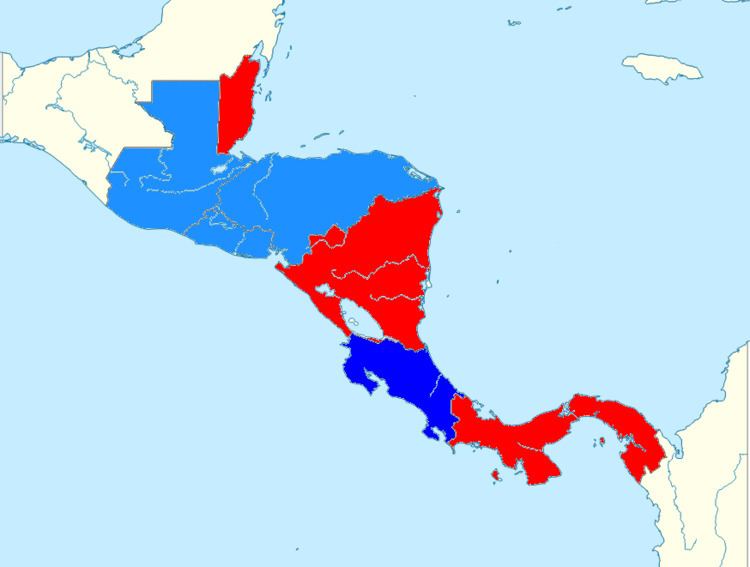Dates 26 May 1991 – 2 Jun 1991 Teams 4 | Venue(s) 1 (in 1 host city) Matches played 6 Attendance 77,500 | |
 | ||
Similar 2009 UNCAF Nations C, 2011 Copa Centroamericana, 1991 CONCACAF Gold Cup, 2014 Copa Centroamericana, 1993 CONCACAF Gold Cup | ||
1991 uncaf nations cup top 7 facts
The 1991 UNCAF Nations Cup was the inaugural UNCAF Nations Cup, the Central American championship for men's national association football teams. It was organized by the Unión Centroamericana de Fútbol or UNCAF, and it took place in Costa Rica from May 26 to June 2, 1991. All matches were played in the Costa Rican capital, San José at the Estadio Nacional. The top two teams, apart from Costa Rica, go on to participate in the 1991 CONCACAF Gold Cup. Costa Rica were given a bye due to their performance at the 1990 FIFA World Cup.
Contents
- 1991 uncaf nations cup top 7 facts
- Host selection
- Qualification
- Qualified teams
- Match Officials
- Stadium
- Mascot
- Squads
- Format
- Goalscorers
- All Star Team
- References
Three teams qualified to enter the tournament alongside hosts Costa Rica, chosen to hold the tournament by UNCAF that same year. The teams played in a round-robin format, with the winner being the squad who obtained the best overall results. The first UNCAF Nations Cup match took place between El Salvador and Guatemala. Since the match ended in a 0-0 draw, the following one between Costa Rica and Honduras produced the first goal in UNCAF Nations Cup history. It was scored by Róger Gómez of Costa Rica. The mascot of the competition was a boy named "Minchito '91".
Hosts and pre-tournament favourites Costa Rica earned 6 points from three wins after defeating Guatemala 1–0 in front of a crowd of 16,500 people, and became the first nation to win the UNCAF Nations Cup.
Host selection
During the Confederation of North, Central American and Caribbean Association Football (CONCACAF) Congress in Guatemala City, Guatemala on January 26, 1991, the qualification rounds for the inaugural CONCACAF Gold Cup was decided upon. Since Costa Rica were given a bye into the competition due to its first place standing at the 1989 CONCACAF Championship, which also served as a qualification phase for the FIFA World Cup hosted by Italy in 1990, they weren't required to participate in the preliminary stages. However, the final qualification round of the Central American zone had two bids: the United States and Costa Rica. Costa Rica won the bid and was named by CONCACAF and UNCAF as the host nation of the inaugural UNCAF Nations Cup tournament on February 19, 1991.
Qualification
The draw for the 1991 UNCAF Nations Cup qualifying competition for Central America took place in Guatemala City on January 26, 1991. Six teams entered to compete for the three remaining places in the competition, alongside eventual host Costa Rica. The teams were divided into three groups of two. As the host nation of the event, Costa Rica qualified automatically. The qualifying process began in April 1991 and concluded in May 1991. At the conclusion of the qualifying group stage, the three group winners qualified for the tournament.
Qualified teams
The following four teams qualified for the finals:
Match Officials
A list of 13 referees from eight football federations for the tournament were chosen to participate in the tournament.
Stadium
The Estadio Nacional, Costa Rica's national stadium and home of the Costa Rica national football team, was announced as the sole venue of the tournament.
Mascot
Minchito '91, the mascot for the 1991 competition, was the first UNCAF Nations Cup mascot, and one of the first mascots to be associated with a major sporting competition in Central America. Inspired in "the traditions, beliefs, legends and customs of Costa Rica", Minchito was born as an authentic peasant. The boy, who is seven-years-old, was created by the Hispanic Publicity Company. The name is a diminutive of the name 'Benjamín' in Costa Rica. Minchito is dressed with a white shirt, a red scarf and belt with black shorts, the most common set of clothes of a Costa Rican peasant.
Squads
Each team's squad consisted of 18 players (two of whom must be goalkeepers). Teams also had two additional reserve players they could use as replacements in the event of serious injury, at any time. During a match, all remaining squad members not named in the starting team are available to be one of the three permitted substitutions (provided the player is not serving a suspension).
Format
All times are Central Time Zone (UTC-6) In the following tables:
The four teams played in round-robin format to determine the winner. This format would guarantee each team at least three games. Each team were awarded 2 points for a win and 1 point for a draw.
If two or more teams were equal on points on completion of the group matches, the following tie-breaking criteria were applied:
- Greatest total goal difference in the three group matches
- Greatest number of goals scored in the three group matches
- If teams remained level after those criteria, a mini-group would be formed from those teams, who would be ranked on:
- Most points earned in matches against other teams in the tie
- Greatest goal difference in matches against other teams in the tie
- Greatest number of goals scored in matches against other teams in the tie
- If teams remained level after all these criteria, UNCAF would hold a drawing of lots
Goalscorers
Claudio Jara received the Golden Boot for scoring five goals. In total, 14 goals were scored by 8 different players.
All-Star Team
Chilean sports magazine Triunfo evaluated player performances through statistical data finished with the following players leading each position.
